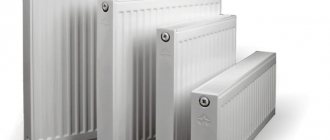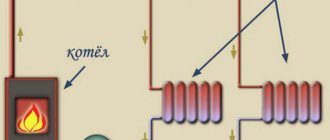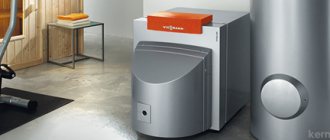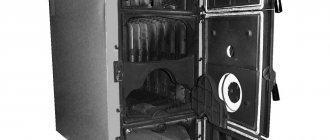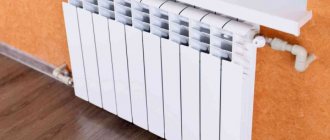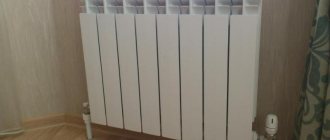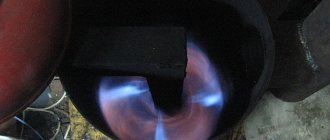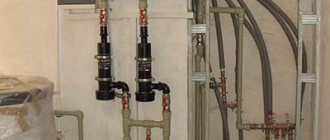Electric heating is an easy and affordable way to heat any room. An electric radiator is the main device of the system; the only necessary condition for its operation is the presence of a power source of sufficient power. Its design includes 2 functional parts:
- heat-dissipating element (metal radiator battery);
- heating element (heater).
A tubular electric heater (TEH) is used as a heating element in electric radiators, which is not fundamentally different from those used in heating devices and household appliances.
With the help of a heat-transfer element, heat is transferred to the room through convective and radiant heat exchange. Developers mainly use sectional batteries to unify the production process and adjust the rated power of individual models by selecting the number of sections.
To buy electric heating radiators which are best suited for the conditions of a particular apartment, you need to choose the right type, number of sections and type of coolant. Also, when choosing, you should pay attention to the functionality of the control unit and the availability of a set of parts for installation.
You can purchase either a fully assembled product or a kit consisting of a control unit and a heating element, which you can independently install in a separately purchased radiator battery.
Classification of electric radiators
Depending on the type of radiator grille, devices are divided into 2 types:
- liquid;
- liquidless.
In liquid models, sections have special channels that are filled with coolant. As in water heating radiators, heat is transferred from the liquid to the metal, after which heat exchange occurs between the sections and the air (convective heat exchange) and objects inside the room (radiant heat exchange). The difference compared to water heating is that in electric radiators there is no circulation of liquid, and its heating is carried out by a heating element.
Diagram and principle of operation of a liquid electric radiator.
It should be noted that liquid electric radiators use sections that are structurally identical to those used in water heating batteries. The radiator of several sections has upper and lower collectors with through holes. A heating element is installed in the lower one, and a Mayevsky tap is mounted in the upper one.
Monolithic liquid electric heater.
Liquid devices can either be connected to a water heating system or operate as a separate heating device. For this purpose, the coolant supply and discharge pipes are equipped with ball valves, which are closed to allow the device to operate in autonomous mode.
Advantages of liquid models
The use of liquid electric radiators as heating elements connected to a centralized water heating system allows you to obtain an effective and economical source of heat. During the heating season, the device is heated by the coolant circulating through the general system, and in the fall and spring, a heating element can be used to heat the liquid.
Models by number of sections.
To keep warm during the several cold weeks before the start of the heating season (and at the end), residents of houses and apartments with central heating purchase additional electrical heating appliances - oil radiators, convectors, infrared heaters and fan heaters. Installing liquid-type electric radiators allows you to avoid purchasing additional heating devices. At the same time, you can save not only money, but also the space needed to store devices during the warm season.
Which coolant is better?
Two types of liquid are used as a coolant in electric radiators - distilled water and non-freezing liquid based on ethylene glycol. When connected to a circulation heating system, the coolant with which the system is filled is used.
Electric radiator with remote control.
Distilled water is used in homes intended for permanent residence. If the building is used as temporary housing, there is a risk that the liquid inside the appliance may freeze, which may cause the product to malfunction. Therefore, in such cases it is filled with non-freezing liquid that can withstand temperatures down to -20 °C.
Types of wall batteries
There are several types of electric wall batteries, differing in operating principle.
Infrared
The operating principle of infrared batteries is to convert electrical energy into thermal radiation. Due to long-wave radiation, the floor and objects on it are heated, which serve as heat transmitters. Heating objects, rather than air, retains heat longer, allowing you to use energy sparingly.
Convector
In electric convectors, heat transfer is carried out by heating the air passing through the device. Warm air increases in volume and exits through the grilles of the device, and cold air enters in its place. Thus, the room warms up very quickly. It is important to prevent the presence of drafts so that the convector does not work uselessly.
Prices for electric wall convector
Oil radiator
The element located inside the radiator heats the intermediate coolant (mineral oil), which then warms up the body of the unit. The oil used retains heat for a long time, allowing you to save on electricity. Oil radiators are cheaper than other types of heaters and have small dimensions. However, heaters of this type warm up the room rather slowly, especially large ones. The surface of the radiator heats up to 150°; this requires careful handling of the device.
Fan heaters
The essence of the operation of fan heaters is to warm up the air flow that passes through the heating element. The air supply to the device is provided by a built-in fan. Most often, fan heaters are used in rooms where maintaining a constant temperature is not required. Many models can be used as a regular fan.
Steam-drip heater
In a paradrip heater system, water is placed in a confined space, which is heated by electricity and turned into steam. Then condensation occurs and the water is returned back to the system with the liquid carrier. This principle of operation of the heater allows you to use two types of energy at once: from the coolant and from steam condensation. After turning off the power, the device retains heat for a long time.
Carbon heating devices
Carbon heaters use carbon fiber placed in a quartz tube as a heater. This is a long-wave emitter that warms up objects in the room, not the air.
Lithium bromide heaters
The lithium bromide radiator consists of vacuum sections filled with lithium and bromide liquid, which turns into steam at a temperature of 35°. The steam rises to the top of the sections, giving off high temperature, and warms up the radiator.
Liquidless radiators
Unlike liquid-type radiators, in liquid-free ones heat transfer from the heating element is carried out directly to the metal heat-transmitting element, without the use of a coolant. They cannot be connected to water heating systems and are installed exclusively as an independent heating device.
Liquid-free wall-mounted radiators with different numbers of sections.
As in liquid radiators, batteries made of several metal sections are used as a heat-transfer element. These sections are not unified with models used in water heating systems. The absence of an intermediate link in the form of a coolant reduces the inertia of the radiator. Liquid-free devices heat up faster, but also cool down faster. They also have less weight, so they are easier to transport from one room to another. In the case of a permanent installation, the lighter weight allows the use of less durable mounts.
Experts recommend installing liquid electric radiators in premises for permanent residence, while inertia-free liquid-free devices are optimal for use in country houses and guest houses, winter recreation centers, retail outlets and mini-hotels.
Mounting options
One of the questions that interests the buyer before purchasing an electric heating radiator is the method of mounting it. Regardless of the model, there are three installation options:
- stationary wall hanging using anchors;
- installation on stands;
- mobile unit on wheels.
Electric radiator hung on the wall.
The methods of permanent installation do not differ from the suspension of traditional radiators of water heating systems. An electric radiator can be installed on any wall that can support its weight in working condition.
Option on wheeled supports.
Mobile installation allows you to easily carry (transport) it from place to place. Not all models are equipped with stands or wheels, so this issue needs to be clarified with the seller before making a purchase. If fasteners are not included in the kit, they can be purchased at an additional cost.
Stable wheel supports.
To provide the air circulation necessary for effective convective heat exchange, it must be installed with the following minimum distances to nearby surfaces:
- from the back wall to the wall – 30 mm;
- to the floor – 50 mm;
- to the window sill - 50 mm.
Installation of a wall convector
You can install the convector by turning to professionals, or on your own in accordance with the manufacturer’s recommendations.
If you install the electric battery yourself, you can use the following step-by-step instructions:
- Remove the device from the packaging and turn it over on its back.
- Unscrew the bracket if it is not packaged separately.
- Attach the mount to the wall and mark the location of the holes with a marker. Consider the manufacturer's recommendations for distances from the floor and walls. If the instructions do not include any, use the following parameters: height from the floor and distance to the nearest objects - 20 cm, gap between the wall - 20 mm, from the outlet - 30 cm.
- For a wooden wall, use self-tapping screws. For concrete, drill holes with a hammer drill and drive in dowels. Next, screw the mounting frame.
- Place the heater on the frame.
- Connect power.
- Set a comfortable temperature.
What is the best way to choose a radiator for a specific room?
On average, the rated power of one section is 0.13 kW. The required number of sections is selected depending on the area of the room according to Table 1. The data presented in the table is relevant for city apartments located in an insulated apartment building. If the room is located on the corner of the building, or the house is poorly insulated, the recommended number of sections should be looked at 1-2 lines below the specified area of the room.
Table 1 - Selection of an electric radiator depending on the area of the room
| Room area, m2 | Recommended number of sections | Rated power, kW | Electricity consumption, kW/hour |
| less than 4 | 3 | 0,39 | 0,10 |
| from 4 to 6 | 4 | 0,52 | 0,15 |
| from 6 to 8 | 5 | 0,65 | 0,20 |
| from 8 to 10 | 6 | 0,78 | 0,25 |
| from 10 to 12 | 7 | 0,91 | 0,30 |
| from 12 to 14 | 8 | 1,04 | 0,35 |
| from 14 to 16 | 9 | 1,17 | 0,40 |
| from 16 to 18 | 10 | 1,30 | 0,45 |
| from 18 to 20 | 11 | 1,43 | 0,50 |
| from 20 to 22 | 12 | 1,56 | 0,55 |
If the area of the room exceeds 22 meters, heating it requires the installation of two or three radiators. It is also recommended to increase the number of radiators if there is more than one window in the room. In this case, heating devices installed under each window create a thermal curtain, reducing the outflow of heat outside the room.
What material should I choose for radiator sections?
The vast majority of models are available with aluminum sections. This material has good thermal conductivity, and sections made from it are lightweight, affordable and attractive in appearance. When using an aluminum radiator as part of a circulation heating system, its internal surfaces are oxidized due to impurities contained in the coolant. Autonomous electric heaters use impurity-free distilled water or an ethylene glycol-based solution as a coolant, which do not react chemically with aluminum.
Aluminum electric radiator.
If desired, heating elements with an electronic control unit can be installed on radiators of any type - if you plan to use previously purchased heating batteries, or the use of an alternative material to aluminum is dictated by the interior design of the room. Thus, electric heating of the coolant can be implemented inside steel, bimetallic, cast iron sections, as well as design radiators made of glass or stone.
Varieties
Quartz radiators can have any pattern to suit your taste.
Don’t know yet about the increasingly popular Kermi heating batteries, price from the manufacturer and detailed description.
The best automation for gas boilers is now available here
Now you can buy monolithic and infrared quartz heaters. Infrared devices differ significantly from monolithic quartz slabs. Their emitters are made of quartz glass, and the heating element is a tungsten heating filament. Infrared quartz heating devices are durable, reliable and mobile. They are not susceptible to atmospheric influences, so they can also be used outdoors.
Quartz heaters are becoming increasingly popular, being a simple solution to a difficult heating issue. They cope well with the function of heating a room and can be used in residential buildings, cottages and in industrial and office premises.
When it becomes necessary to choose an electrical appliance for heating a room, buyers are primarily interested in the efficiency and economy of the heater. Quartz batteries fully meet these main requirements. With a monolithic quartz slab, all heating-related problems are immediately solved. Having analyzed the characteristics of MKTEN. we can say that this is the most economical and efficient heating device. which, if necessary, can replace a traditional heating system or become an effective addition to it.
temperature sensor
Modern electric radiators automatically adjust the heating intensity depending on the air temperature in the heated room. This parameter is measured using a temperature sensor, which can have two designs:
- built into the control unit housing;
- remote
If the radiator is intended to be installed permanently as the main source of heating, it is better to choose a model with a remote air temperature sensor. This option provides a more reliable temperature measurement, since the sensor is located at some distance from the radiator, in the immediate vicinity of which the air is always warmer than at a distance.
Where is the best place to mount the remote sensor?
If the device is equipped with a remote temperature sensor, it is mounted on the surface of the wall closest to the radiator. The distance from the sensor to the floor surface must be at least 1 meter, and to the radiator - at least 0.5 meters.
It is prohibited to place the sensor in a draft or in a place where there is direct sunlight, as this may affect the accuracy of the measurement. It is also not recommended to mount the sensor on the floor or windowsill.
Makes and models
The modern heating equipment market offers a fairly wide range of electric radiators. There are both domestic and foreign brands here. Here are just the most popular:
- Effective Energy from St. Petersburg;
- KievEcoGroup;
- Teplokom, Russia.
These three manufacturers offer liquid-type electric heating batteries.
Efficient Energy
The liquid radiator model is called a Mini-boiler. This is an aluminum device from 3 to 10 sections, inside of which antifreeze is poured. The package includes an automation unit that provides 7 temperature settings. Plus, the device is equipped with a programmer, a Multitariff block and a sensor, with the help of which the heating temperature of the body of the device itself is controlled.
KievEcoGroup
This company produces a liquid model under the Eranova brand. This is the same aluminum radiator, consisting of 3-12 sections.
Additional options: programmer, cascade connection, Multitariff and Antifreeze.
Teplokom
The company produces one of the most popular brands of liquid radiators, Teplolux. There are several options in its model line, depending on the power of the heating unit itself. Eg:
- HLA-8R-B/ХР power 1200 W, sections – 8.
- HLA-12R-B/ХР power 1800 W, sections – 12.
Operating modes
When choosing a radiator that is best suited for specific operating conditions, the buyer needs to pay attention to the number of modes of its operation, as well as a description of each mode. Modern radiators assume the following operating modes:
- Basic mode. The radiator heats up to the set temperature and then turns off. When the air temperature decreases by a certain amount (usually 0.5 - 1.0°C), the heating element comes back into operation.
- Economy mode. Tuned a few degrees lower than the main one. It turns on if the room is empty for some time. The difference between main and economy mode is configurable.
- Programmable mode. The radiator switches from mode to mode depending on the specified time of day. The program can be set for a specific time (day, week). The control unit allows you to configure several operating modes, and then easily switch between them.
Six-section radiator with programmable timer.
By design
Oil (water) electric heating radiators. They are distinguished by their simplicity of design. A tubular electric heater (TEH) installed in the lower manifold heats the liquid inside the device, then the temperature is transferred to the body. The built-in thermostat protects the device from overheating and maintains the set room temperature.
Convection type. They are also heated by a heating element, but the heat is transferred directly to the body of the device. Since there is no liquid in the device, heating occurs faster and its weight is less.
The air, passing through the body of the radiator, heats up and rushes upward, displacing the colder air downwards, which again passes through the body of the radiator, heating up.
The operating principle of such a device is called convection, and the batteries themselves are called convectors.
Infrared. These devices work on a different principle. They do not heat the air directly, but transfer thermal energy to surrounding objects and the air is heated directly from them. The battery itself remains cold.
During operation, no harmful substances are released, oxygen or dust is not burned. In addition, IR batteries are the most economical electric heating radiators.
Fan heaters. They consist of a heated coil or plates and a fan that supplies a flow of cold air to the heated element.
Such a device heats the air quickly enough, is small in size, and can be easily moved to any convenient place. The downside is the fan noise and the fact that the device makes the air dry.
Electrical safety measures
To ensure safe operation of the device, the following safety precautions must be observed:
- When connecting to the power supply, grounding must be used.
- It is not recommended to connect the device to the same outlet as other electrical appliances, as this may cause overloading of the wiring.
- The actual parameters of the electrical network should not exceed the limits specified in the operating instructions.
- Air humidity in the room should not exceed 80%.
- The radiator should be regularly wiped from dust and moisture should not be allowed to get into its electrical part.
